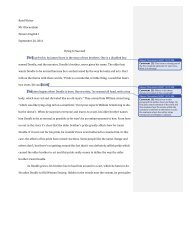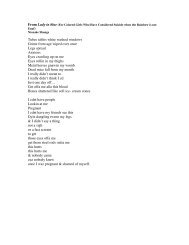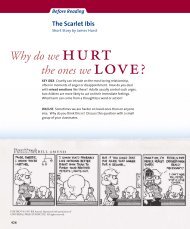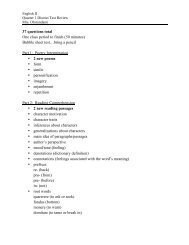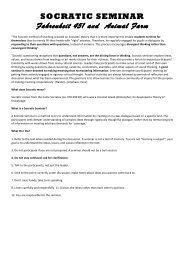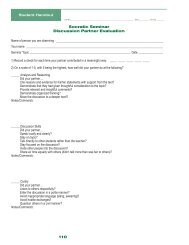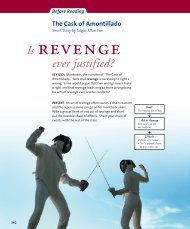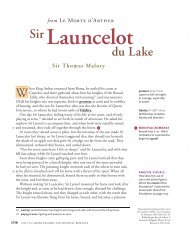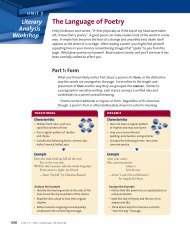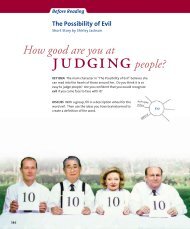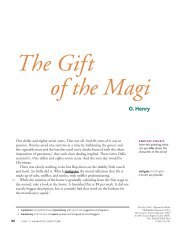Carl Sagan - LanguageArts-NHS
Carl Sagan - LanguageArts-NHS
Carl Sagan - LanguageArts-NHS
Create successful ePaper yourself
Turn your PDF publications into a flip-book with our unique Google optimized e-Paper software.
<strong>Carl</strong> <strong>Sagan</strong><br />
10<br />
Fifty-one thousand human beings were killed or wounded here, ancestors of<br />
some of us, brothers of us all. This was the first full-fledged example of an<br />
industrialized war, with machine-made arms and railroad transport of men and<br />
materiel. This was the first hint of an age yet to come, our age; an intimation<br />
of what technology bent to the purposes of war might be capable. The new<br />
Spencer repeating rifle was used here. In May 1863, a reconnaissance balloon<br />
of the Army of the Potomac 1 detected movement of Confederate troops<br />
across the Rappahannock River, the beginning of the campaign that led to the<br />
Battle of Gettysburg. That balloon was a precursor of air forces and strategic<br />
bombing and reconnaissance satellites.<br />
A few hundred artillery pieces were deployed in the three-day battle of<br />
Gettysburg. What could they do What was the war like then . . . Ballistic<br />
projectiles, launched from the cannons that you can see all over this<br />
Gettysburg Memorial, had a range, at best, of a few miles. The amount of<br />
explosive in the most formidable of them was some twenty pounds, roughly<br />
one-hundredth of a ton of TNT. 2 It was enough to kill a few people. a<br />
But the most powerful chemical explosives used eighty years later, in<br />
World War II, were the blockbusters, so-called because they could destroy a<br />
city block. Dropped from aircraft, after a journey of hundreds of miles, each<br />
ANALYZE VISUALS<br />
In what other contexts<br />
have you seen images like<br />
this one used<br />
precursor (prG-kûrPsEr) n.<br />
something that comes<br />
before and signals or<br />
prepares the way for what<br />
will follow<br />
a INDUCTIVE<br />
REASONING<br />
What statistics does <strong>Sagan</strong><br />
provide as evidence in<br />
lines 1–16<br />
1. Army of the Potomac: the Union army that defeated Confederate forces near the town<br />
of Gettysburg, Pennsylvania. The battle was a turning point in the Civil War.<br />
2. TNT: a chemical compound used as an explosive.<br />
594 unit 6: argument and persuasion
The Soldiers’ National Cemetery in Gettysburg National Military Park<br />
20<br />
30<br />
carried about ten tons of TNT, a thousand times more than the most powerful<br />
weapon at the Battle of Gettysburg. A blockbuster could kill a few dozen people.<br />
At the very end of World War II, the United States used the first atomic<br />
bombs to annihilate two Japanese cities. Each of those weapons had the<br />
equivalent power of about ten thousand tons of TNT, enough to kill a few<br />
hundred thousand people. One bomb.<br />
A few years later the United States and the Soviet Union developed the<br />
first thermonuclear 3 weapons, the first hydrogen bombs. Some of them had<br />
an explosive yield equivalent to ten million tons of TNT; enough to kill a few<br />
million people. One bomb. Strategic nuclear weapons can now be launched to<br />
any place on the planet. Everywhere on earth is a potential battlefield now. b<br />
Each of these technological triumphs advanced the art of mass murder by<br />
a factor of a thousand. From Gettysburg to the blockbuster, a thousand times<br />
more explosive energy; from the blockbuster to the atomic bomb, a thousand<br />
times more; and from the atomic bomb to the hydrogen bomb, a thousand<br />
times still more. A thousand times a thousand, times a thousand is a billion;<br />
in less than one century, our most fearful weapon has become a billion times<br />
more deadly. But we have not become a billion times wiser in the generations<br />
that stretch from Gettysburg to us. c<br />
annihilate (E-nFPE-lAt’) v.<br />
to destroy completely<br />
b INDUCTIVE REASONING<br />
How is the evidence in<br />
this paragraph related to<br />
evidence provided earlier<br />
in the speech<br />
c RHETORICAL DEVICES<br />
Reread lines 32–38. What<br />
idea does <strong>Sagan</strong> stress<br />
through the use<br />
of parallelism<br />
3. thermonuclear (thûrQmI-nLPklC-Er): based on the process of nuclear fusion, in which atomic nuclei<br />
combine at high temperatures, releasing energy.<br />
596 unit 6: argument and persuasion
40<br />
50<br />
60<br />
70<br />
The souls that perished here would find the carnage of which we are now<br />
capable unspeakable. Today, the United States and the Soviet Union have<br />
booby-trapped our planet with almost sixty thousand nuclear weapons. Sixty<br />
thousand nuclear weapons! Even a small fraction of the strategic arsenals<br />
could without question annihilate the two contending superpowers, probably<br />
destroy the global civilization, and possibly render the human species extinct.<br />
No nation, no man should have such power. We distribute these instruments<br />
of apocalypse 4 all over our fragile world, and justify it on the grounds that it<br />
has made us safe. We have made a fool’s bargain.<br />
The 51,000 casualties here at Gettysburg represented one-third of the<br />
Confederate army and one-quarter of the Union army. All those who died,<br />
with one or two exceptions, were soldiers. The best-known exception was a<br />
civilian in her own house who thought to bake a loaf of bread and, through<br />
two closed doors, was shot to death; her name was Jennie Wade. But in the<br />
global thermonuclear war, almost all the casualties will be civilians, men,<br />
women, and children, including vast numbers of citizens of nations that<br />
had no part in the quarrel that led to the war, nations far removed from the<br />
northern mid-latitude “target zone.” There will be billions of Jennie Wades.<br />
Everyone on earth is now at risk. . . . d<br />
Two months before Gettysburg, on May 3, 1863, there was a Confederate<br />
triumph, the Battle of Chancellorsville. On the moonlit evening following the<br />
victory, General Stonewall Jackson and his staff, returning to the Confederate<br />
lines, were mistaken for Union cavalry. Jackson was shot twice in error by his<br />
own men. He died of his wounds.<br />
We make mistakes. We kill our own.<br />
There are some who claim that since we have not yet had an accidental<br />
nuclear war, the precautions being taken to prevent one must be adequate.<br />
But not three years ago we witnessed the disasters of the Challenger 5 space<br />
shuttle and the Chernobyl 6 nuclear power plant, high-technology systems, one<br />
American, one Soviet, into which enormous quantities of national prestige had<br />
been invested. There were compelling reasons to prevent these disasters. In<br />
the preceding year, confident assertions were made by officials of both nations<br />
that no accidents of that sort could happen. We were not to worry. The experts<br />
would not permit an accident to happen. We have since learned that such<br />
assurances do not amount to much.<br />
We make mistakes. We kill our own. e<br />
This is the century of Hitler and Stalin, evidence—if any were needed—that<br />
madmen can seize the reins of power of modern industrial states. If we are<br />
content in a world with nearly sixty thousand nuclear weapons, we are betting<br />
our lives on the proposition that no present or future leaders, military or<br />
civilian—of the United States, the Soviet Union, Britain, France, China, Israel,<br />
carnage (kärPnGj) n.<br />
massive slaughter<br />
contending<br />
(kEn-tDnPdGng) adj.<br />
struggling in rivalry<br />
contend v.<br />
d INDUCTIVE REASONING<br />
What new point does<br />
<strong>Sagan</strong> make with the<br />
historical evidence he<br />
discusses in lines 48–57<br />
e<br />
GRAMMAR AND STYLE<br />
The two simple sentences<br />
in line 74 also appear<br />
earlier and later in the<br />
speech. Consider how<br />
this repetition serves<br />
to link and emphasize<br />
essential points.<br />
4. apocalypse (E-pJkPE-lGpsQ): total devastation.<br />
5. Challenger: an American space shuttle that exploded in 1986, killing all seven crew members.<br />
6. Chernobyl (chEr-nIPbEl): a town in the Ukraine (then part of the Soviet Union) that was the<br />
site of a major nuclear power plant accident in 1986.<br />
on nuclear disarmament 597
80<br />
90<br />
100<br />
110<br />
120<br />
India, Pakistan, South Africa, and whatever other nuclear powers there will<br />
be—will ever stray from the strictest standards of prudence. We are gambling<br />
on their sanity and sobriety even in times of great personal and national crisis,<br />
all of them, for all times to come. I say this is asking too much of us. Because<br />
we make mistakes. We kill our own. . . .<br />
We have made a fool’s bargain. We have been locked in a deadly embrace<br />
with the Soviet Union, each side always propelled by the abundant<br />
malefactions of the other; almost always looking to the short term—to the<br />
next congressional or presidential election, to the next party congress—and<br />
almost never seeing the big picture.<br />
Dwight Eisenhower, who was closely associated with this Gettysburg<br />
community, said, “The problem in defense spending is to figure out how far<br />
you should go without destroying from within what you are trying to defend<br />
from without.” I say we have gone too far. . . .<br />
The Civil War was mainly about union; union in the face of differences. A<br />
million years ago, there were no nations on the planet. There were no tribes.<br />
The humans who were here were divided into small family groups of a few<br />
dozen people each. They wandered. That was the horizon of our identification,<br />
an itinerant family group. Since them, the horizons have expanded. From<br />
a handful of hunter-gatherers, to a tribe, to a horde, to a small city-state, to<br />
a nation, and today to immense nation-states. The average person on the<br />
earth today owes his or her primary allegiance to a group of something like a<br />
hundred million people. It seems very clear that if we do not destroy ourselves<br />
first, the unit of primary identification of most human beings will before<br />
long be the planet Earth and the human species. To my mind, this raises the<br />
key question: whether the fundamental unit of identification will expand to<br />
embrace the planet and the species, or whether we will destroy ourselves first.<br />
I’m afraid it’s going to be very close.<br />
The identification horizons were broadened in this place 125 years ago, and<br />
at great cost to North and South, to blacks and whites. But we recognize that<br />
expansion of identification horizons as just. Today there is an urgent, practical<br />
necessity to work together on arms control, on the world economy, on the<br />
global environment. It is clear that the nations of the world now can only rise<br />
and fall together. It is not a question of one nation winning at the expense of<br />
another. We must all help one another or all perish together. f<br />
On occasions like this it is customary to quote homilies; phrases by great<br />
men and women that we’ve all heard before. We hear, but we tend not to<br />
focus. Let me mention one, a phrase that was uttered not far from this spot<br />
by Abraham Lincoln: “With malice toward none, with charity for all. . . .”<br />
Think of what that means. This is what is expected of us, not merely because<br />
our ethics command it, or because our religions preach it, but because it is<br />
necessary for human survival.<br />
f INDUCTIVE REASONING<br />
What conclusion does<br />
<strong>Sagan</strong> draw in lines<br />
108–114<br />
malice (mBlPGs) n. a desire<br />
to harm others<br />
598 unit 6: argument and persuasion
130<br />
140<br />
Here’s another: “A house divided against itself cannot stand.” Let me vary<br />
it a little: A species divided against itself cannot stand. A planet divided<br />
against itself cannot stand. And [to be] inscribed on this Eternal Light Peace<br />
Memorial, which is about to be rekindled and rededicated, is a stirring phrase:<br />
“A World United in the Search for Peace.”<br />
The real triumph of Gettysburg was not, I think, in 1863 but in 1913,<br />
when the surviving veterans, the remnants of the adversary forces, the Blue and<br />
the Gray, met in celebration and solemn memorial. It had been the war that set<br />
brother against brother, and when the time came to remember, on the fiftieth<br />
anniversary of the battle, the survivors fell, sobbing, into one another’s arms.<br />
They could not help themselves.<br />
It is time now for us to emulate them, NATO and the Warsaw Pact, 7 Israelis<br />
and Palestinians, whites and blacks, Americans and Iranians, the developed<br />
and the underdeveloped worlds.<br />
We need more than anniversary sentimentalism and holiday piety and<br />
patriotism. Where necessary, we must confront and challenge the conventional<br />
wisdom. It is time to learn from those who fell here. Our challenge is to<br />
reconcile, not after the carnage and the mass murder, but instead of the<br />
carnage and the mass murder.<br />
It is time to act. <br />
reconcile (rDkPEn-sFl’) v. to<br />
restore friendly relations<br />
7. Warsaw Pact: an alliance of the Soviet Union and other Communist nations.<br />
on nuclear disarmament 599
After Reading<br />
Comprehension<br />
1. Recall What weapons were used in the Battle of Gettysburg<br />
2. Recall What developments in warfare occurred during and shortly<br />
after World War II<br />
3. Summarize According to <strong>Sagan</strong>, why should we reject assurances<br />
that a nuclear war will not occur<br />
Critical Analysis<br />
4. Examine a Rhetorical Device What idea does <strong>Sagan</strong> emphasize with his<br />
repetition of the statement, “We have made a fool’s bargain”<br />
5. Examine an Argument <strong>Sagan</strong> states that as society has evolved, humans<br />
have gone from identifying with small groups to identifying with enormous<br />
nation-states. How does this idea relate to the main claim of his argument<br />
6. Interpret a Statement What does <strong>Sagan</strong> mean when he says that “the real<br />
triumph of Gettysburg” was the behavior of surviving veterans who attended<br />
the 50th anniversary of the battle, in 1913<br />
7. Analyze Inductive Reasoning Review the graphic organizer you created as you<br />
read. Does <strong>Sagan</strong> provide sufficient support for his conclusion about nuclear<br />
weapons and security Explain why or why not.<br />
8. Analyze a Conclusion At the end<br />
of his speech, <strong>Sagan</strong> says it is<br />
“time to act” to prevent nuclear<br />
war. In a chart like the one shown,<br />
identify specific actions that<br />
individuals and groups can take in<br />
response to <strong>Sagan</strong>’s call for action.<br />
Preventing Nuclear War<br />
Individual Actions<br />
• •<br />
• •<br />
• •<br />
Group Activities<br />
9. Compare Texts Compare and<br />
contrast the techniques of<br />
argument used in <strong>Sagan</strong>’s speech and Alan Blinder’s editorial “Abolishing the<br />
Penny Makes Good Sense.”<br />
10. Evaluate Explanations <strong>Sagan</strong> became famous for helping the general public<br />
understand scientific concepts. How well does he explain the complex issues<br />
involved with nuclear weapons Cite evidence to support your opinion.<br />
600 unit 6: argument and persuasion



